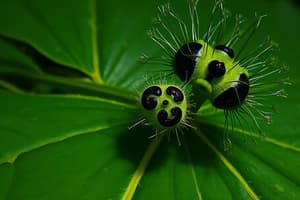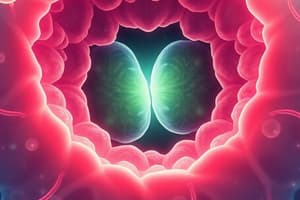Podcast
Questions and Answers
Which of the following organisms is capable of reproducing via regeneration?
Which of the following organisms is capable of reproducing via regeneration?
- Hydra (correct)
- Honeybees
- Fungi (correct)
- All of the above
What is the result of spermatogenesis?
What is the result of spermatogenesis?
- Formation of oogonia
- Formation of diploid gametes
- Formation of haploid gametes (correct)
- Formation of spermatogonia
What is the function of Sertoli cells in the seminiferous tubules?
What is the function of Sertoli cells in the seminiferous tubules?
- Surrounding and nourishing sperm (correct)
- Storing sperm
- Producing spermatozoa
- Transporting sperm
Which of the following is an example of binary fission?
Which of the following is an example of binary fission?
What is the term for the process of an unfertilized egg developing into a viable organism?
What is the term for the process of an unfertilized egg developing into a viable organism?
What is the site of sperm production in the human body?
What is the site of sperm production in the human body?
What is the final stage of spermatogenesis?
What is the final stage of spermatogenesis?
What is the function of inhibin produced by Sertoli cells?
What is the function of inhibin produced by Sertoli cells?
What is the function of the epididymis in the male reproductive system?
What is the function of the epididymis in the male reproductive system?
What is the role of seminal vesicles in the male reproductive system?
What is the role of seminal vesicles in the male reproductive system?
What is the function of the midpiece of a sperm cell?
What is the function of the midpiece of a sperm cell?
What is the role of the prostate gland in the male reproductive system?
What is the role of the prostate gland in the male reproductive system?
What is the function of the uterus in the female reproductive system?
What is the function of the uterus in the female reproductive system?
What is the role of follicle-stimulating hormone (FSH) in the male reproductive system?
What is the role of follicle-stimulating hormone (FSH) in the male reproductive system?
What is the process called when oogonia die via apoptosis?
What is the process called when oogonia die via apoptosis?
What is the stage of oogenesis at which oocytes are arrested in prophase I?
What is the stage of oogenesis at which oocytes are arrested in prophase I?
Flashcards are hidden until you start studying
Study Notes
Asexual Reproduction
- Binary fission: a method used by unicellular organisms (prokaryotes and mitochondria and chloroplasts of eukaryotes) where DNA is replicated and cell divides into two separate cells.
- Budding: a method used by organisms like hydra and yeast, where a bud forms, receives a copy of DNA, and breaks off to create a new individual.
- Regeneration: a method used by organisms like hydra, planaria, and fungi, where a new individual can grow from a broken piece or a fragment.
- Parthenogenesis: a method used by some organisms, like honeybees, where an unfertilized egg develops into a viable offspring.
Human Reproduction - Sexual Reproduction
- Sexual reproduction: the joining of two gametes (male sperm and female egg) to create offspring.
- Gametes are produced by germ cells (male spermatogonia, female oogonia) through meiosis.
Spermatogenesis
- Spermiogenesis: the final stage of spermatogenesis, where haploid spermatids differentiate into mature, motile spermatozoa.
- Spermatogenesis: the formation of mature spermatozoa from spermatogonia, involving two meiotic divisions to produce 4 spermatids.
- Spermatogenesis occurs in seminiferous tubules of testes, involving Sertoli cells and spermatogenic cells.
- Sperm are transported through epididymis, vas deferens, and ejaculatory duct to be ejaculated out of the penis as semen.
Sperm Structure
- Head: contains nucleus and acrosome.
- Midpiece: contains mitochondria for ATP production.
- Tail: long flagellum (microtubules) for propulsion.
Accessory Glands
- Seminal vesicles: secrete fructose, viscous mucus, and prostaglandins.
- Prostate gland: secretes alkaline fluids to counteract uterine acidity.
- Bulbourethral glands: secrete viscous mucus that cleans and lubricates the urethra.
Hormones in Males
- Follicle stimulating hormone (FSH): stimulates sperm development in seminiferous tubules.
- Luteinizing hormone (LH): stimulates Leydig cells to produce testosterone.
- Testosterone: matures sperm and gives rise to male secondary sex characteristics.
Female Anatomy and Oogenesis
- Vagina: opens to an external environment where sperm enters and birth occurs.
- Uterus: a muscular, vascular organ that provides an ideal environment for fertilized eggs to implant and develop.
- Ovary: produces eggs (ova) that travel through the oviduct to the uterus.
Oogenesis
- Many oogonia are produced, with the majority dying via apoptosis, and a small fraction differentiating into primary oocytes that begin meiosis but are arrested in prophase I until puberty.
- At puberty, one egg per month ovulates, completing meiosis I, and producing a large secondary oocyte and a polar body.
Studying That Suits You
Use AI to generate personalized quizzes and flashcards to suit your learning preferences.




